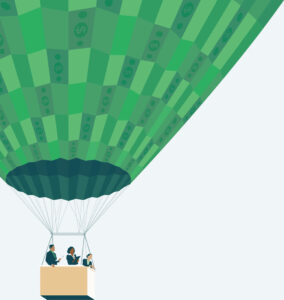 Escalating inflation adds another layer atop rising losses
Escalating inflation adds another layer atop rising losses
The year-end loss reserving season was a bit different this year for Chris Gross, CEO of Gross Consulting. For the first time in a decade, he added an explicit adjustment to reserve estimates to reflect higher inflation expectations. Although the adjustment is subjective, he said, it will help prepare his clients for the future. At the very least, he offered, reserving actuaries should acknowledge the changing inflation environment in their actuarial reports.
From loss reserving to pricing and rating, changing inflation trends are having an impact on property-casualty insurance. “Inflation leaves its imprint on practically every aspect of the insurance industry,” said Jeremy P. Pecora, who spearheads the Willis Towers Watson Claim Cost Index.
For property-casualty insurers, soaring inflation is exacerbating already-escalating loss trends. Although economists in early 2022 were optimistic that accelerating inflation would subside by the end of the year, the fallout from recent world events is likely to pressure inflation upwards into 2023. Russia’s war against Ukraine and major COVID-19 lockdowns in China are affecting prices and global supply chains, fanning the flames of inflation and slowing the pace of economic growth in the U.S.
Said James Auden, managing director and P&C sector head for Fitch Ratings’ North American insurance rating group, “For actuaries, previous claims and loss payment experience may be less helpful in projecting future losses going forward in this environment.” Auden added that both economic uncertainty and inflation concerns “are key factors promoting demand for coverage and [the] likelihood that rising premium rates in many lines will continue into 2023.”
An economy in flux
P&C insurance experts began ringing inflation alarm bells about a year ago. While consumers started to tighten their belts in response to rising food and energy costs, insurers were already experiencing rising repair and replacement costs.
When inflation rates are stable and predictable, insurers can easily adjust. During transition periods when inflation shifts dramatically, factoring for inflation is like chasing a moving target. A shift in monthly inflation can be temporary or it could be a sign of more to come.
Inflation began climbing as the U.S. economy quickly recovered from the pandemic-driven recession in 2020 and intensified in 2021, said Robert P. Hartwig, clinical associate professor at the finance department and director of the Center for Risk and Uncertainty Management at the University of South Carolina. The Consumer Price Index (CPI) from 2019 to 2020 rose a barely perceptible 1.4%, but then jumped to 4.7% in 2021, according to the U.S. Bureau of Labor Statistics (BLS). The development marked the fastest pace of increase in the general price level since the Great Recession of 2008.
From the post-Great Recession period until a year ago, a decade of tepid but predictable U.S. Treasury note and bond returns have challenged insurers’ capacity to bridge the gap between rising losses and collected premium.
Property Coverage — Homeowners and Commercial
Like auto insurance, loss trends for property coverage were rising before COVID-19 disrupted the economy. “Property insurance costs, in particular lumber and construction wages, are where the headline inflation is,” said Conning’s Bill Burns.
After five years of record-breaking weather events, property insurers were rethinking deductibles and coverage limits before the COVID-19 pandemic lockdowns began in March 2020. Commercial property insurers then were also encouraging customers to take risk management more seriously while raising deductibles and tightening underwriting.
While Mother Nature continues to be relentless, the COVID-19 pandemic ushered in multifold complications to repairing and replacing property. From December 2019 through December 2021, the price of construction materials rose by 44.1%, with some lumber prices in mid-2021 up 400%, said Robert P. Hartwig.
The high cost of lumber is not just due to growing demand, he said. But the lack of truck drivers impacting the supply chain, fewer mills, and tariffs imposed by the U.S. on Canadian lumber are contributing to higher building costs. The cost increases contribute to higher costs reflected in the shelter category in the CPI, which includes owned and rented dwellings.
Shelter costs, which cover overall housing prices, make up 32% of the CPI. According to the BLS, costs within the shelter category increased 1.8% in 2020 and 4.1% in 2021. “We see housing going up with inflation through 2022,” said Molly Boesel, principal economist at CoreLogic, explaining that actual rents are higher than what the CPI is showing because it takes nine to 12 months for market change to appear in the CPI.
From December 2020 to December 2021, Boesel said that rent and housing prices combined went up across the board quickly by 11% to 12%. The CoreLogic HPI shows an 18.8% gain. “Higher rents are linked to the continuing rise in home prices,” she added.
The first two months of 2022 ushered in the fastest inflation growth since the early 1980s. Month over month, the CPI rose by 0.8% in February after a 0.6% increase in January, according to the BLS. In March, the CPI rose an additional 1.2%, fueled by the gasoline index, which rose 18.3% in March, along with other increasing energy component indexes. For the 12-month period ending March 2022, the all-items index escalated to 8.5%, marking the largest increase since the period ending December 1981, according to the BLS.
Much of the inflation surge stems from the fallout of the COVID-19 pandemic and associated lockdowns that began in March 2020. Hartwig said that the $5.7 trillion in relief and stimulus dollars, supply chain disruptions, labor shortages and energy market disruptions are all contributing factors. The Federal Reserve Board’s recent rate hike — with many more expected to come — represents the Fed’s primary response tool for combating rising prices, he added.
From the post-Great Recession period until a year ago, a decade of tepid but predictable U.S. Treasury note and bond returns have challenged insurers’ capacity to bridge the gap between rising losses and collected premium.
Anticipating the impact of future inflation is tough. Past high inflationary periods took place in different economic circumstances. For example, high unemployment and double-digit inflation defined a decade of misery from 1974 to 1983, Hartwig said. However, U.S. Treasury yields — pushed into the double digits by actual and anticipated inflation — allowed insurers to materially increase investment income. During the 1990s, the CPI hovered around 5% and was steady.
Globalization and the offshoring of production during the past 40 years resulted in increased efficiency. At the same time, U.S. dependence on other countries for raw materials and production capacity increased. Supply chains were stretched thin, assuring that major disruptions outside the United States would produce ripple effects on the U.S. economy. The Russian attack on Ukraine and renewed lockdowns in China are two recent examples; both have been pressuring prices in the U.S. by disrupting supplies of oil, grain, fertilizer and other materials that are necessary for everything from growing food to manufacturing semiconductors. The looming potential for World War III makes investors more nervous.
Such conditions make it more difficult to anticipate future inflation. Earlier this year, insurance economists were assuming that reinvigorated supply chains, higher interest rates and low unemployment rates would pressure inflation downward in the second half of 2022.
But that is changing.
Auto — Personal and Commercial
Before COVID-19 adversely affected the U.S. economy, auto insurers had already started to replace newer vehicles rather than repair them because it was less expensive (see “Moving Parts,” AR November-December 2019). Upgrading to a new or newer car has become more costly due to COVID-19-associated supply chain shortages, particularly those involving computer shortages. Sanctions against Russia for its attack on Ukraine means nickel and palladium, essential for building electric vehicles, could be harder to procure.
More expensive repair and replacement costs are not the only influences on losses. Commercial auto coverage has been “bleeding a lot,” suffering the worst combined ratio results compared to other lines, partially due to repair and replacement costs, said Sridhar Manyem, director of industry research & analytics at A.M. Best. “Before COVID-19 arrived, social inflation, rather than economic inflation, was pressuring the line,” he added (see “Commercial Auto Woes,” AR May-June 2019 and “Tipping the Scales,” AR July-August 2020).
However, Bill Burns said that from 2004 to 2011, the insurance industry dropped prices for commercial auto almost 35% and has been playing catch up for the last several years. While social inflation is likely having some effect on commercial auto results, he observed, if the industry had charged more responsible prices during this seven-year period, the deterioration in results would have been less severe.
Fitch revised its inflation estimate. Instead of inflation falling to 2.6% at the end of 2022, the rating company is now forecasting that inflation will decelerate to 4.5% by year’s end, eventually declining to 2.6% in 2023, according to the organization’s “Global Economic Outlook — March 2022.” The report noted that the forecast adjustment is due to “faster Fed rate hikes than anticipated, tighter financial conditions and the drag on real incomes from rising inflation,” and the likelihood of less fiscal support than assumed in its December report.
Hartwig continues to readjust inflation as more information becomes available. In mid-February, before Russia’s invasion of Ukraine, he estimated that the annual inflation rate for 2022 would run about 5.5%. Today, that estimate is up sharply at 7.5%. Even before 2022’s inflationary surge, the insurance industry was already paying more for some specific vital goods and services, he said.
Rather than boost interest rates by 50 basis points in March as initially anticipated, the Fed prescribed a lower increase of 25 basis points with promises of six more rate hikes. The Fed anticipates that fighting inflation is becoming more complex, marking the first interest rate increase since 2018.
Growing Losses
Citing BLS data, Hartwig noted that from January 2020 to January 2022, the cost of new and used vehicles surged by 54.6%, putting significant pressure on the CPI. Auto manufacturer supply chain issues are expected to linger well into 2022. Personal auto insurance premiums, he said, which make up 1.57% of the CPI, are expected to rise by 3.5% to 5% in 2022 (see sidebar, “Auto — Personal and Commercial”). Property insurance costs have also risen significantly (see sidebar, “Property Coverage — Homeowners and Commercial”).
From 2015 to 2020, eight P&C lines measured by the Willis Towers Watson Claim Cost Index were above the CPI. The index, which Pecora said is frequently used in reserving analyses to adjust losses to present value, can be used as an indicator of the rate of change in claim severity. The index is based on several sources, including the CPI and producer price index (PPI), to reflect “insurance inflation.”
General inflation adds a layer of about 1.25% to 1.50% to insurance inflation, Pecora said. The index’s composite insurance inflation rate has been outpacing the overall inflation rate for each year from 2013 to 2021 (preliminary), excluding 2018.
This is where inflation comes into play as part of the actuary’s assessment of future average costs of claims; even if inflation is low, the average cost of claims generally goes up.
Actuarial Adjustments
In ratemaking, claims severity is estimated by looking at a variety of internal and external data to make actuarially appropriate selections, said Steven D. Armstrong, FCAS, past president of the Casualty Actuarial Society. “This is where inflation comes into play as part of the actuary’s assessment of future average costs of claims,” he said, adding that even if inflation is low, the average cost of claims generally goes up.
Inflation Poised to Impact Workers’ Compensation
Workers’ compensation, which can cover injured employees’ wage replacement and medical benefits for decades until death, is a classic long-tailed line.
Medical costs, which typically make up about 50% of loss costs, have held steady overall. Year over year, the medical cost category of the consumer price index (M-CPI) rose 2.4% from February 2021 to 2022, said John W. Ruser, president of the Workers’ Compensation Research Institute (WCRI).
WCRI publishes an annual medical price index (MPI) for professional services in workers’ compensation based on 31 states. From 2008 to 2020, the MPI increased by 19% in the median state, or about 1.5% per year, according to the most recent report released in May 2021. “This is lower than the 1.9% per year increase in the CPI-M Professional Services,” said Ruser, who worked for the U.S. Bureau of Labor Statistics, which publishes the CPI.
Fee schedules are helping to quell medical inflation, Ruser said, adding containing medical costs with provider networks are also seeing promising results. Meanwhile, wage inflation is starting to appear in the most recent BLS data, he said. “Wage increases in the range of 5% are being seen in average weekly wages — higher than any time in the past two decades,” he observed.
Workers’ compensation “is the one line with flat to declining pricing currently in response to strong profits,” said James Auden, managing director and P&C sector head for Fitch Ratings’ North American insurance rating group. Past experience shows workers’ compensation and general liability are more vulnerable to persistent high inflation due to compounding effects and difficulty in estimating losses in these segments,” he added.
Jeremy P. Pecora said specific medical components within the CPI are on the rise, including hospital costs, drugs and rehabilitation. “The CPI for drugs seems understated given all the press we read about for increasing drug cost,” he added.
Armstrong said that the actuarially justified rate increases in personal auto in this current environment can reach double digits. “Not all companies willfully act on these actuarial projections because the impact of the consumer needs to be considered,” he added. This is especially true when inflation is already weighing on customers due to higher food, gas and energy costs. Armstrong adds that this is part of the continuous balance of achieving needed premium and maintaining customer growth and retention.
Underestimating inflation leads to higher-than-expected future liabilities, said Bill Burns, ACAS, insurance research director of Conning. Depending on the line of business, a 1% increase in inflation, he added, could result in an average 2% to 3% increase on the calendar-year loss ratio.
“If inflation is expected to rise 3% a year, but actual inflation is 4%, future losses will rise in varying amounts by line of business, based on the duration of the liabilities,” Burns said. For example, a 1% unexpected increase in inflation would affect the combined ratio for short-tailed lines, such as auto and property coverage, by around 1%. However, for a long-tailed line of business such as medical malpractice, Burns said, the same 1% higher-than-expected inflation hike may increase the combined ratio by more than five points (see sidebar, “Inflation Poised to Impact Workers’ Compensation”).
“Development factors are influenced by inflation,” Gross said, but the impact of a shift in inflation can take years to be fully reflected in selected development patterns. “There are external predictions of future inflation levels available, but at the end of the day, those are estimates as well,” he added. Actuaries should consider several predictions of inflation, Gross said. “The difference between a treasury yield and a TIPS (Treasury Inflation-Protected Securities) yield is one example,” he advised.
While working as a life actuary early in his career, Gross learned to pay attention to demographics. A significant change in demographics in China, for instance, will impact inflation in the U.S.. “China has helped keep inflation down in the United States,” he said, because its citizens worked for low wages. However, China’s workforce is no longer growing, he said, which could allow prices to rise more in the future.
Development factors are influenced by inflation, but the impact of a shift in inflation can take years to be fully reflected in selected development patterns.
Actuaries should consider new processes. “Reserving and pricing,” he added, “need to be linked.” By developing individual claim reserves based on actuarial principles rather than claim department case reserves, actuaries can watch and measure the impact of inflation on claims much more quickly and respond in reserving and pricing.
Conclusion
Accounting for inflation is tricky, whether the actuary is pricing premium or setting reserves. The past can be forward-predictive in some potential ways. At the same time, the insurance industry is facing never-before-seen circumstances. As Gross said, actuaries must at least mention inflation in their reports to prepare regulators, the C-suite, investors and others that inflation could intensify already-challenging circumstances. Looking for new ways to detect inflation’s influence will make a big difference as well.
Annmarie Geddes Baribeau has been covering insurance and actuarial topics for more than 30 years. You can reach her by writing annmarie@insurancecommunicators.com.











